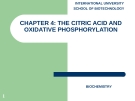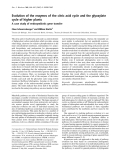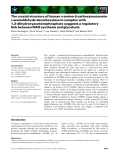
Citric acid cycle
-
Early metabolic steps, including glycolysis and the activity of the pyruvate dehydrogenase complex, yield a two-carbon fragment called an acetyl group, which is linked to a large cofactor known as coenzyme A (or CoA). It is during the citric acid cycle that acetyl-CoA is oxidized to the waste product, carbon dioxide, along with the reduction of the cofactors NAD+ and ubiquinone
 94p
94p  zingzing09
zingzing09
 21-10-2012
21-10-2012
 61
61
 9
9
 Download
Download
-
Carbohydrate Metabolism: Glycolysis, Citric acid cycle, Gluconeogenesis, Glycogen metabolism. Invite you to consult for additional documents for the academic needs and research.
 22p
22p  kimtuoi2410
kimtuoi2410
 22-09-2015
22-09-2015
 62
62
 3
3
 Download
Download
-
The citric acid or tricarboxylic acid cycle is a central element of higher-plant carbon metabolism which provides, among other things, electrons for oxidative phosphorylation in the inner mitochondrial membrane, intermediates for aminoacid biosynthesis, and oxaloacetate for gluconeogenesis from succinate derived from fatty acids via the glyoxylate cycle in glyoxysomes. The tricarboxylic acid cycle is a typical mitochondrial pathway and is widespread among a-proteobacteria, the group of eubacteria as de®ned under rRNA systematics from which mitochondria arose. ...
 16p
16p  research12
research12
 01-06-2013
01-06-2013
 48
48
 4
4
 Download
Download
-
The enzyme a-amino-b-carboxymuconate-e-semialdehyde decarboxylase (ACMSD) is a zinc-dependent amidohydrolase that participates in picolinic acid (PA), quinolinic acid (QA) and NAD homeostasis. Indeed, the enzyme stands at a branch point of the tryptophan to NAD pathway, and deter-mines the final fate of the amino acid, i.e. transformation into PA, com-plete oxidation through the citric acid cycle, or conversion into NAD through QA synthesis.
 9p
9p  viettel02
viettel02
 20-02-2013
20-02-2013
 41
41
 4
4
 Download
Download
CHỦ ĐỀ BẠN MUỐN TÌM
















